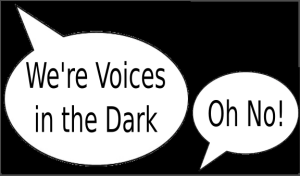Table of Contents
Voices in the Dark
 A scene that is all dialogue and no action creates the dreaded “voices in the dark”. Perhaps they're at a conference table, or standing around talking things through before making a decision that will propel the story into its next phase.
A scene that is all dialogue and no action creates the dreaded “voices in the dark”. Perhaps they're at a conference table, or standing around talking things through before making a decision that will propel the story into its next phase.
The problem with such scenes is they become lack-lustre, and somehow they seem amateurish and not quite up to the same standard of our favourite authors.
Creating Unnecessary Action
The problem with these scenes is they tend to be rather dead, no matter how much we liven up the dialogue. As writers, we're often told to stay focussed on the story and to eliminate anything not essential. It's also a fact that in writing every rule can be broken if you know what you are doing. The reason the scene seems dead, lacklustre or the voices seem to be coming out of a lightless void, is because there is no action. Adding action brings the world to life and creates immersion, and also helps the reader to visualise the characters and connect with them. Why? Because the characters cease to be actors reading a script, they become real people inhabiting a real world.
Adding unnecessary action - that is action not relevant to the story - turns out to be necessary after all.
In some cases, this is pretty easy. Judy and Mom are having a discussion in the kitchen. Instead of having them immobile, sipping cups of tea, Mom could be preparing dinner. Under her expert ministrations, tomatoes get a little cross cut in them and then dunked in freshly boiled water and peeled; bell-peppers are sliced into small squares; parsley is reduced to a fine powder; onions are chopped, causing both women to get irritated eyes and leaking tears. All the while, Judy is passing whatever her mother needs next and making coffee in the percolator (because that's how they like it). See how the scene comes alive?
Other cases, such as a video-conference or a group of executives discussing a problem around a conference table, are much harder to bring to life. There is only so much eyebrow-raising, finger-pointing, sipping (or slurping) coffee and fidgeting uncomfortably in their seats that you can get away with. You need to get inventive. They've probably got a small pile of notes in front of them, so when challenged with a question, they might rifle through their notes looking for what they need. The woman vacuuming the corridor outside might be irritating and distracting the POV character. Someone's stomach might be rumbling, and you can create a micro side-plot as everyone (silently, because nobody is actually going to talk about it) tries to determine who it is.
Radio communications are probably the worst you'll have to deal with, because at least one of the voices really is coming out of the void. Anyone in an environment suit - whether that's a spacesuit or a hazmat suit - has difficulty seeing the faces and expressions of their companions. If they're connected via radio, the usual social mores of turning to face the person they're talking to goes out the window. Facial expressions are used a lot in writing, from grimacing to grinning and from frowning to rolling the eyes.
Building a relationship between two (or more) people when you can't show facial expressions and, because you can't rely on them facing each other, use body language effectively, is incredibly difficult. It has to be done through dialogue, and so the natural tendency is to make the scene dialogue heavy. Give your actors a task, even if it's only waving a Geiger counter or chemical sniffer wand around. Also pay attention to inflection. If someone sounds a little unsure, dubious or afraid, make it a subtle thing the POV character picks up on and maybe has to ask a question to verify. In the absence of all the other visual clues, hearing becomes a little more sensitive to such things.
Summary
Adding unnecessary action turns out to be necessary after all, when the scene is too dialogue heavy. The trick is to add enough to bring the scene to life, but not so much that it becomes distracting and the story you were trying to tell gets lost amongst all the wordage.
